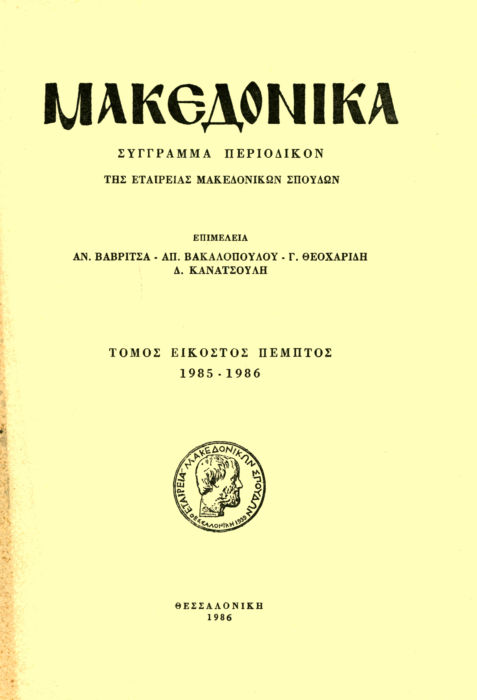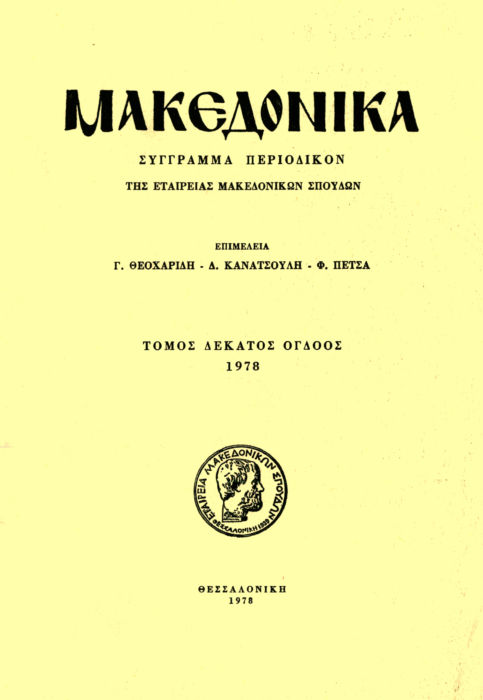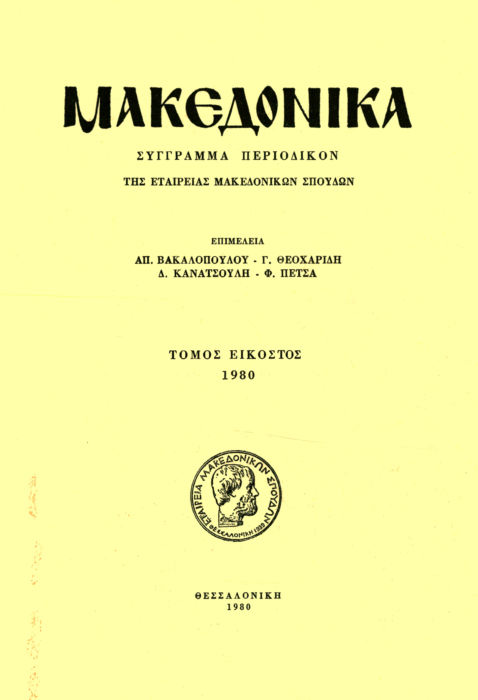The individual grants of the Roman citizenship (civitas Romana) and its expansion in the Roman province of Macedonia: II. The case of Beroea, seat of the Macedonian koinon
Abstract
In the frame of a wider study on the subject of the grant of the Roman citizenship and the expansion of the Roman civil law in the Roman provinces of the Balkan Peninsula, we have already published the results of our re search concerning the Roman province of Thrace (Dim. C. Samsaris, Re search on the history, topography and cults of the Roman provinces of Macedonia and Thrace, V. The policy of the Roman Emperors concerning the civil law in the Roman province of Thrace, Thessaloniki 1984, pp. 131 sqq.), the consequences and application of the constitutio Antoniniana in the Roman province of Macedonia («Offering to Prof. C. Vavouskos». vol. I. Thessaloniki 1989, pp. 339-353) and the individual grants of the Ro man citizenship to inhabitants of Thessaloniki, capital of the province of Macedonia («Makedonika» XXVI, 1988, pp. 308-353).
From the point of view of method for identifying the peregrinos granted with the Roman citizenship, we classify them, as in the case of Thessaloniki, into three groups. In the first group we classify: 1) those bearing the gentilicia of Emperors (189 persons): 46 Adii, 8 M. Aurelii, 54 Iulii, 47 Claudii, 4 Ulpii, 2 Septimii and 28 Flavii\ 2) those bearing the gentilicia belonging to Roman magistrates of the Macedonia province; those are seven persons: Antestii, Cassii and Fabii. The second goup consists of 27 persons with a gentilicium common among the Roman magistrates of the Macedonia province and the Italian traders (negotiatores): Aemilii, Annii, Iunii, Clodii, Cornelii, Licinii, Marcii, Meminii, Vettii, Pcmponii, Pontii and Sextii. Finally, in the third group we enlist 103 persons bearing either a gentilicium of Roman magistrates of the neighbouring and the other orien tal provinces or a gentilicium common among those magistrates: 1) Avidii, Didii, Domita, Gelili, luventii, Caesennii, Caesernii, Cornimi, Lapii, Marii, Mestrii, Puplicii, Sergii, Sossii and Statii; 2) Attii, Aufidii, Munatii, Valerli, Ofellii, Pelronii, Popìllii, Rutilii, Sembronii, Sulpicii, Turpilii and Fabricii.
The article ends with general conclusions and verifications. Thus we establish that the peregrini of Beroea who had become Roman citizens reach the number of 326: 196 persons (60,1%) of the first group, 27 persons (8,3%) of the seccond group and 103 persons (31,6%) of the third. We also find out that on a whole of 326 persons who received the Roman citizenship 189 persons (58%) are bearing the gentilicium of Emperors and 34 (10,4%) the getilicium of Roman magistrates of Macedonia. We come as well to the conclusion that the individual grants of the civiias Romana to the peregrinos of Beroea begins in the 1st c.B.C. and is growing, as in the case of Thessaloniki, during the period of Julio-Claudian dunasty. During the following dynasties the naturalisations’ rythm is varying. Thus we have the highest percentage in the period of Antonins with a peak during- the reign of Hadrian.
With regard to the social dimensions of the naturalizations’ phenomenon, we notice that a high percentage over of the 50% affects members of the local aristocracy. This indicates that this particular social class of Beroea was, as elsewhere, the basis of the Roman power.
Finally our research has proved that: 1) the expansion of the Roman citizenship and the Roman civil law in Beroea did not result the onomastic Romanization of its inhabitants; 2) Beroea, as seat of the Macedonian koinon, was the second city of Macedonia, after Thessaloniki, especially favoured by the Roman policy concerning the individual grants of the Roman citizenship
Article Details
- How to Cite
-
Σαμσάρης Δ. Κ. (1989). The individual grants of the Roman citizenship (civitas Romana) and its expansion in the Roman province of Macedonia: II. The case of Beroea, seat of the Macedonian koinon. Makedonika, 27(1), 327–382. https://doi.org/10.12681/makedonika.106
- Issue
- Vol. 27
- Section
- Articles

This work is licensed under a Creative Commons Attribution-NonCommercial-ShareAlike 4.0 International License.
Authors who publish with this journal agree to the following terms:
- Authors retain copyright and grant the journal right of first publication with the work simultaneously licensed under a Creative Commons Attribution Non-Commercial License that allows others to share the work with an acknowledgement of the work's authorship and initial publication in this journal.
- Authors are able to enter into separate, additional contractual arrangements for the non-exclusive distribution of the journal's published version of the work (e.g. post it to an institutional repository or publish it in a book), with an acknowledgement of its initial publication in this journal.
- Authors are permitted and encouraged to post their work online (preferably in institutional repositories or on their website) prior to and during the submission process, as it can lead to productive exchanges, as well as earlier and greater citation of published work (See The Effect of Open Access).








